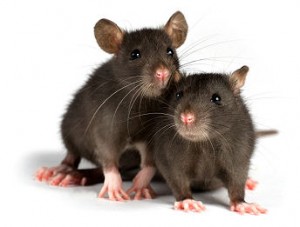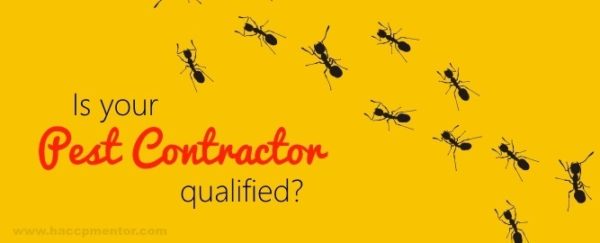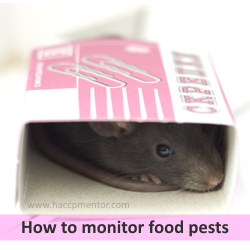My faith in effective pest control has been renewed this week. After auditing a medium sized bakery, I was pleasantly surprised to find that I did not have to raise a corrective action request for any level of pest infestation. I think it had a lot to do with the fact that it was a newly constructed building with an exceptional level of cleanliness.
The presence of pests within food premises is not a given and this attitude held by many food businesses needs to change. Failure to maintain adequate pest control may result in your business being fined, prosecuted or ending up on a “Name and Shame” database.
The Law in Australia
The Food Standards Code, 3.2.2 Clause 24 – Animals and Pests, clearly states that a food business must take all practicable measures to prevent pests from entering the food premises and to also eradicate and prevent the harbourage of pests. Pests can include (but not limited to) rodents, mice, cockroaches, flies, moths, ants, birds, beetles and spiders.
German Cockroaches
A common problem faced by not only bakeries but the entire food industry is controlling German cockroaches. German Cockroaches thrive where there is warmth, food, water and harborage areas. They also breed continuously with many overlapping generations present at any one time. Considering that the life cycle of the German cockroach is around 100 days (from egg to adult)
There may be from 30 to 50 eggs in the capsule of the German cockroach, so there is the potential for up to fifty more cockroaches to be in your food business when they have hatched. In a lifetime, a female cockroach is capable of producing up to one million eggs.
This makes it difficult to manage and eradicate German Cockroaches – but it can be done using a range of non-chemical methods in addition to pest service chemical treatments. Talk to your external pest contractor about recommended durations between chemical pest control – keeping in mind the overlapping breeding cycle of German cockroaches.
7 Non-chemical pest control methods
(1) Secure food ingredients – Make sure that all food ingredients in containers have tight fitting lids in place. Ingredients in bags or cartons should be not damaged and remain intact. Store all ingredients up off the ground and rotate regularly to prevent pest harbourage points.
(2) Cleanliness – having a clean food business will eliminate food scraps, residue and smells that attract pests. Clean means you can’t see, smell or feel any dirt, dust, food residue or spills.
(3) Eliminate water – Avoiding any pooling of moisture including in sinks can assist in eliminating a pests water source. German cockroaches can survive only 12 days with food but no water. However, if only water is present with no food, cockroaches can survive for about 42 days.
(4) Prevent harbourage – Remove areas where pests can harbour. This involves removing any build up of packaging, equipment and food ingredients. Store all items up off the floor. Limit the amount of signage on walls and regularly move or check behind and in fire fighting equipment eg. fire blankets, extinguishers.
(5) Good Construction – ensuring there are good fitting windows and doors which are closed at all times will prevent pests from entering your premises. Well constructed floors, walls, ceilings and equipment should eliminate cracks and crevices in which pests can hide and harbour.
(6) Lids on garbage bins – controlling the storage of waste both inside and outside will reduce pests from being attracted to waste food smells. Making sure that external skip bins have their lids in place will reduce birds from making your business a regular visiting place.
(7) Good lighting – pests prefer darker settings and thrive when it is dark and activity is at a minimum. Make sure the business has both good natural and artificial lighting.
With any pest control and eradication program it is essential to have a good reporting process in place. You can be certain that if you see one pest there will be plenty more that you don’t see. A pest sightings register can help your business log pest activity and then take appropriate action.
Need a pest sightings log? Visit HACCP Templates at www.haccptemplates.com




Thanks, I didn’t think to include lighting as an item to watch, but I see why did. Cockroaches are a frequent visitor in our areas and these tips are spot on.
Glad to help out Mike 🙂
Loving the 7 methods you pointed out. I’ve been in the pest industry for some time now and i must say, if homeowners were to do their due diligence taking these necessary steps, it would definitely reduce the chance of a pest infestation. “Prevention is better than cure” in relation to pest control and extermination.
Thank you for your valuable insight! I’ll be sure to share.
Two thumps up from me.
Thanks 🙂
Great information! There are a lot of things that people can do to protect their dwelling spaces from pests. Usually when people dwell within a space, that is all it takes to keep pests out just because they do complete a lot of these things that you have listed. Great information!
Thanks Toby!
Thanks for the info. I am so glad that there are people to do pest control for me. I can’t stand the thought of little creatures crawling up my arm. I doubt that’s what happens, but it still freaks me out.